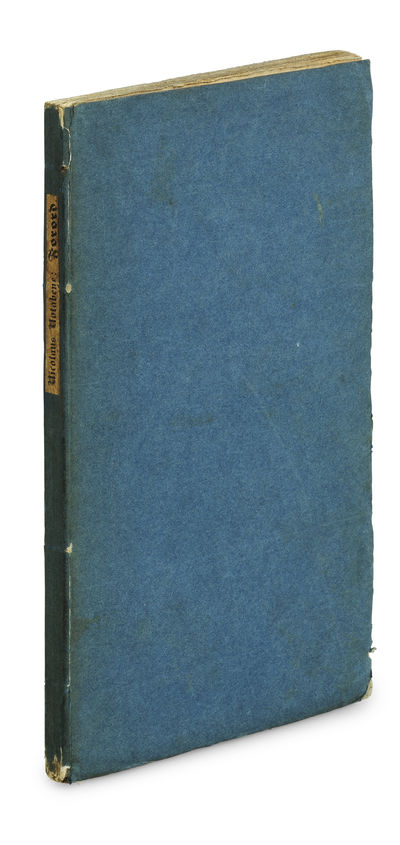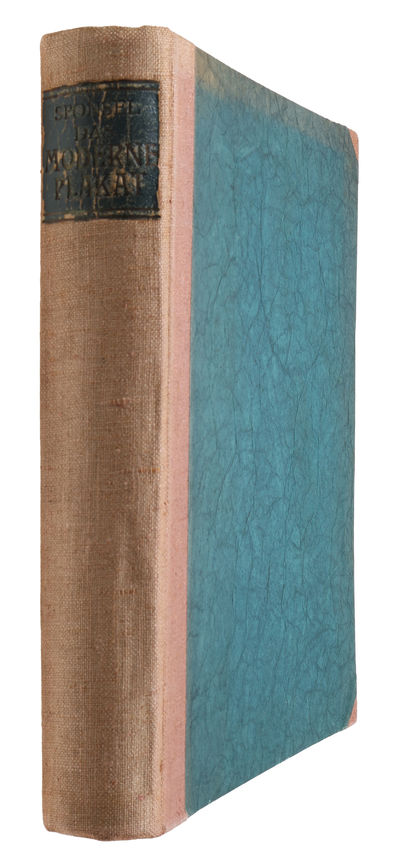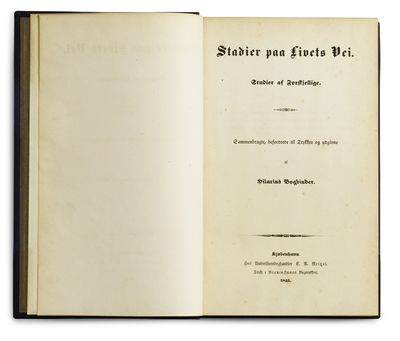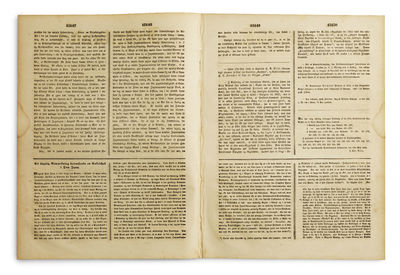JARDINE BART.t., SIR W.
British Salmonidae. 2 parts. - [ONE OF THE FINEST BOOKS ON FISH EVER PRODUCED]
Herman H. J. Lynge & Søn A/S
lyn40374
(Edinburgh, 1839-41). Elephant-folio. In the two original half-calf-folders with green leather-spines and pattern-stamped cloth boards; gilt title and author to front boards. Remains of the original green cloth-ties. Some wear to spines, especially at capitals. 12 magnificent hand-coloured plates with one leaf of text for each, the first, 8th and 11th text-leaves with an engraved illustration measuring 22x13,5 cm. (depicting "Stake Nets of the Solway Firth", "Poke Nets of the Solway Firth", and "Young States of S. Truttafrom Mr. Shaw's Ponds" - the last beautifully hand-coloured); all leaves laid in loose, as originally published, and all plates with the original tissue-guards. Plates and text-leaves measuring ab. 64,5 x 49 cm
The exceedingly scarce first printing of this monumental work on British salmon, one of the finest books on fishes ever produced. The work is generally considered the Audubon of salmons; the quality of the plates is considered unsurpassed and the scientific research that lies behind it makes it of the utmost importance to the study of salmons."Jardine was a keen sportsman, expert with rod and gun, and followed his hounds. He was not averse to making deer which strayed from his neighbour's estate onto Jerdine Hall land pay for their trespass. He was also an amateur artist, working in watercolours, and exhibited, as an honorary member, at the Scottish Royal Academy, as well as other art exhibitions in Dumfries. When writing his books, he learned to etch, to draw on wood blocks for wood engraving, to lithograph and to use a variant of lithography called papyrography. One of the finest books of fishes ever printed was Jardine's "The British Salmonidae", for which he did the drawings and etchings himself.Jardine was the foremost ichthyologist in Scotland, perhaps even in the United Kingdom, in the nineteenth century. He was a fine fisherman and fished the Annan, which flowed through his grounds in Dumfriesshire, and the best stretches of the Tweed when he lived for three years at St Boswells, Roxburghshire. One of his aims was to establish his life cycles of the salmon and the sea trout, for which he tagged fish in a specially constructed pool at Jardine Hall, and visited the fisheries at Perth where experiments were carried out. His reputation as a fly fisherman was well known, and he enjoyed many days of sport with other eminent naturalists such as P.J. Selby, John Gould, Richard Parnall, as well as friends and neighbours. His interest in fishing and fisheries led to his appointment as one of the royal commissioners to the Salmon Fisheries Survey of England and Wales in 1860." (Jackson and Davis, "Sir William Jardine. A Life in Natural History", p. X). Jardine was also famous for his huge museum collections, among these a very extensive collection of skins. In the late 1820'ies the collections began to encompass vertebrates other than birds, and it is from this time that his scientific interests in fish began to develop. Although Jardine's interest had always extended beyond the British Isles and he also received many specimens of fish from abroad, his main interest remained British fish, and especially those of the salmon family, which greatly fascinated him. "Some of these were little known, and even in the early nineteenth century were considered rare." (Jackson & Davis, p. 57). From around the beginning of the 1830'ies Jardine was on the lookout for more specimens and further advice, and he began corresponding with the famous Cornish naturalist and ichthyologist, Jonathan Couch. He also began corresponding with other respected scientists and correspondents and with much support from all of these, Jardine devoted more and more of his time and effort to investigating fish, especially the salmon family. In 1834 he began a tour of Sutherland that came to have a significant impact on his studies of the salmon family. He brought Selby with him, and due to their many notes, drawings, and observations, Jardine now had the confidence to present a lecture, in which he revised the scientific status of the Salmonidae discovered on their excursion, to the British Association, which he held in Edinburgh during the late summer of 1834. It is this lecture that established his reputation as an ichthyologist, and it is evident from many sources of the period that he was now much admired within this field. "[w]hen he attended the British Association meeting in Newcastle in August 1838, not only did he chair the Botany and Zoology section, but he also gave a lecture on the Salmonidae of Scotland. By this time he was bringing to fruition a much more ambitious project, with the preparation of the plates for the "Illustrations of British Salmonidae, with Descriptions", which was published in two parts in 1839 and 1841." (Jackson & Davis, p. 60).Jardine had originally planned to work on the project with Selby and had already suggested him this in 1834. Selby supported him throughout the project, but eventually Jardine undertook the work alone. The illustrations of the work were to comprise the salmons of both England and Ireland, and in a letter to T.C. Eyton he indicates many of his thoughts concerning the production as well as his continued interest in fishes around the world; he describes his wish to illustrate the specimens life-size, although that would restrict sales, his and Lizar's frustrations of finding a skilled enough colourist, as well as his view on drawing the fish directly at the edge of the water in order to capture the iridescence and colours of the fish straight away, so that they would not have had time to fade, which they do rapidly after death. Among other things he writes "The sale will of course be limited & one to my list is important. If it will clear its way I shall be satisfied so far as the plates are concerned... but Illustrations of the size which I have chosen are always attended with more expense in the publication than those of a less [?] size. All the drawings have been made at the waters edge, and I am sanguine that the work will be creditable to all both artist and engraver... The 1st number will be out in a very short time it is all prepared except the colouring which we have been annoyed about in the north. We have however now selected Mr. Gould' colourer [Gabriel Bayfield] in London, & from what he has put out in these departments we have considerable reliance." (See Jackson & Davis, p. 61).Thus, the plates were etched by Jardine himself and coloured by Bayfield. The first number of plates were sent to Bayfiled for colouring in July 1838, and the first part of "Illustrations" was advertised as published in August 1839, whereas the second was ready in September 1841. "It is not known how many copies were eventually sold, but Jardine (who had exclusive rights to the publication) hinted in 1844 that "There are only 70 copies coloured" - and indication that few coloured copies were to hand after supplying copies to the subscribers. Lizars had been responsible for producing and distributing the books, but when his establishment in Edinburgh closed, Jardine transferred the stock of uncoloured plates to Jardine Hall. Even in the 1860s there was a demand for copies of the Salmonidae, and also for individual plates, and the faithful Bayfield was asked once more to act as colourist for these. Some indication of the price of the complete work is given by Jardine in a letter to John Gould, asking him to deliver a copy to Pickering in Picadilly and asking him "to take payment for £5 16". Initially prices of £2 12s 6d (coloured) and £1 11s 6d (plain) per part had been suggested, which had risen to £3 3s 0d by August 1839. The first estimates also suggested that an initial run of some 50 copies was sensible until the demand could be gauged, and noted that the cost of colouring each impression was 1s 6d." (Jackson & Davis, p. 62).The work is now considered one of the finest books on fish ever produced, both due to its great artistic value and its "meticulous and painstaiking scientific research" (p. 62); besides its scientific value and scientific importance, it is of the greatest scarcity with no more than 70 copies (at the most) produced, and many fewer that have survived. Nissen 2092; not in Wood;
The exceedingly scarce first printing of this monumental work on British salmon, one of the finest books on fishes ever produced. The work is generally considered the Audubon of salmons; the quality of the plates is considered unsurpassed and the scientific research that lies behind it makes it of the utmost importance to the study of salmons."Jardine was a keen sportsman, expert with rod and gun, and followed his hounds. He was not averse to making deer which strayed from his neighbour's estate onto Jerdine Hall land pay for their trespass. He was also an amateur artist, working in watercolours, and exhibited, as an honorary member, at the Scottish Royal Academy, as well as other art exhibitions in Dumfries. When writing his books, he learned to etch, to draw on wood blocks for wood engraving, to lithograph and to use a variant of lithography called papyrography. One of the finest books of fishes ever printed was Jardine's "The British Salmonidae", for which he did the drawings and etchings himself.Jardine was the foremost ichthyologist in Scotland, perhaps even in the United Kingdom, in the nineteenth century. He was a fine fisherman and fished the Annan, which flowed through his grounds in Dumfriesshire, and the best stretches of the Tweed when he lived for three years at St Boswells, Roxburghshire. One of his aims was to establish his life cycles of the salmon and the sea trout, for which he tagged fish in a specially constructed pool at Jardine Hall, and visited the fisheries at Perth where experiments were carried out. His reputation as a fly fisherman was well known, and he enjoyed many days of sport with other eminent naturalists such as P.J. Selby, John Gould, Richard Parnall, as well as friends and neighbours. His interest in fishing and fisheries led to his appointment as one of the royal commissioners to the Salmon Fisheries Survey of England and Wales in 1860." (Jackson and Davis, "Sir William Jardine. A Life in Natural History", p. X). Jardine was also famous for his huge museum collections, among these a very extensive collection of skins. In the late 1820'ies the collections began to encompass vertebrates other than birds, and it is from this time that his scientific interests in fish began to develop. Although Jardine's interest had always extended beyond the British Isles and he also received many specimens of fish from abroad, his main interest remained British fish, and especially those of the salmon family, which greatly fascinated him. "Some of these were little known, and even in the early nineteenth century were considered rare." (Jackson & Davis, p. 57). From around the beginning of the 1830'ies Jardine was on the lookout for more specimens and further advice, and he began corresponding with the famous Cornish naturalist and ichthyologist, Jonathan Couch. He also began corresponding with other respected scientists and correspondents and with much support from all of these, Jardine devoted more and more of his time and effort to investigating fish, especially the salmon family. In 1834 he began a tour of Sutherland that came to have a significant impact on his studies of the salmon family. He brought Selby with him, and due to their many notes, drawings, and observations, Jardine now had the confidence to present a lecture, in which he revised the scientific status of the Salmonidae discovered on their excursion, to the British Association, which he held in Edinburgh during the late summer of 1834. It is this lecture that established his reputation as an ichthyologist, and it is evident from many sources of the period that he was now much admired within this field. "[w]hen he attended the British Association meeting in Newcastle in August 1838, not only did he chair the Botany and Zoology section, but he also gave a lecture on the Salmonidae of Scotland. By this time he was bringing to fruition a much more ambitious project, with the preparation of the plates for the "Illustrations of British Salmonidae, with Descriptions", which was published in two parts in 1839 and 1841." (Jackson & Davis, p. 60).Jardine had originally planned to work on the project with Selby and had already suggested him this in 1834. Selby supported him throughout the project, but eventually Jardine undertook the work alone. The illustrations of the work were to comprise the salmons of both England and Ireland, and in a letter to T.C. Eyton he indicates many of his thoughts concerning the production as well as his continued interest in fishes around the world; he describes his wish to illustrate the specimens life-size, although that would restrict sales, his and Lizar's frustrations of finding a skilled enough colourist, as well as his view on drawing the fish directly at the edge of the water in order to capture the iridescence and colours of the fish straight away, so that they would not have had time to fade, which they do rapidly after death. Among other things he writes "The sale will of course be limited & one to my list is important. If it will clear its way I shall be satisfied so far as the plates are concerned... but Illustrations of the size which I have chosen are always attended with more expense in the publication than those of a less [?] size. All the drawings have been made at the waters edge, and I am sanguine that the work will be creditable to all both artist and engraver... The 1st number will be out in a very short time it is all prepared except the colouring which we have been annoyed about in the north. We have however now selected Mr. Gould' colourer [Gabriel Bayfield] in London, & from what he has put out in these departments we have considerable reliance." (See Jackson & Davis, p. 61).Thus, the plates were etched by Jardine himself and coloured by Bayfield. The first number of plates were sent to Bayfiled for colouring in July 1838, and the first part of "Illustrations" was advertised as published in August 1839, whereas the second was ready in September 1841. "It is not known how many copies were eventually sold, but Jardine (who had exclusive rights to the publication) hinted in 1844 that "There are only 70 copies coloured" - and indication that few coloured copies were to hand after supplying copies to the subscribers. Lizars had been responsible for producing and distributing the books, but when his establishment in Edinburgh closed, Jardine transferred the stock of uncoloured plates to Jardine Hall. Even in the 1860s there was a demand for copies of the Salmonidae, and also for individual plates, and the faithful Bayfield was asked once more to act as colourist for these. Some indication of the price of the complete work is given by Jardine in a letter to John Gould, asking him to deliver a copy to Pickering in Picadilly and asking him "to take payment for £5 16". Initially prices of £2 12s 6d (coloured) and £1 11s 6d (plain) per part had been suggested, which had risen to £3 3s 0d by August 1839. The first estimates also suggested that an initial run of some 50 copies was sensible until the demand could be gauged, and noted that the cost of colouring each impression was 1s 6d." (Jackson & Davis, p. 62).The work is now considered one of the finest books on fish ever produced, both due to its great artistic value and its "meticulous and painstaiking scientific research" (p. 62); besides its scientific value and scientific importance, it is of the greatest scarcity with no more than 70 copies (at the most) produced, and many fewer that have survived. Nissen 2092; not in Wood;
Adress:
Silkegade 11
DK-1113 Copenhagen Denmark
Telefon:
CVR/VAT:
DK 16 89 50 16
E-post:
Webb:
![British Salmonidae. 2 parts. - [ONE OF THE FINEST BOOKS ON FISH EVER PRODUCED] (photo 1)](https://d3525k1ryd2155.cloudfront.net/h/718/806/1188806718.0.l.0.jpg)
![British Salmonidae. 2 parts. - [ONE OF THE FINEST BOOKS ON FISH EVER PRODUCED] (photo 2)](https://d3525k1ryd2155.cloudfront.net/h/718/806/1188806718.1.l.2.jpg)
![British Salmonidae. 2 parts. - [ONE OF THE FINEST BOOKS ON FISH EVER PRODUCED] (photo 3)](https://d3525k1ryd2155.cloudfront.net/h/718/806/1188806718.2.l.2.jpg)





